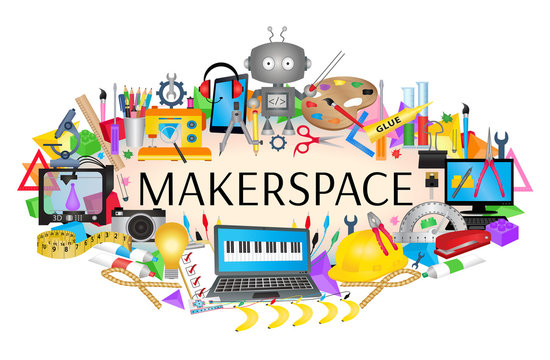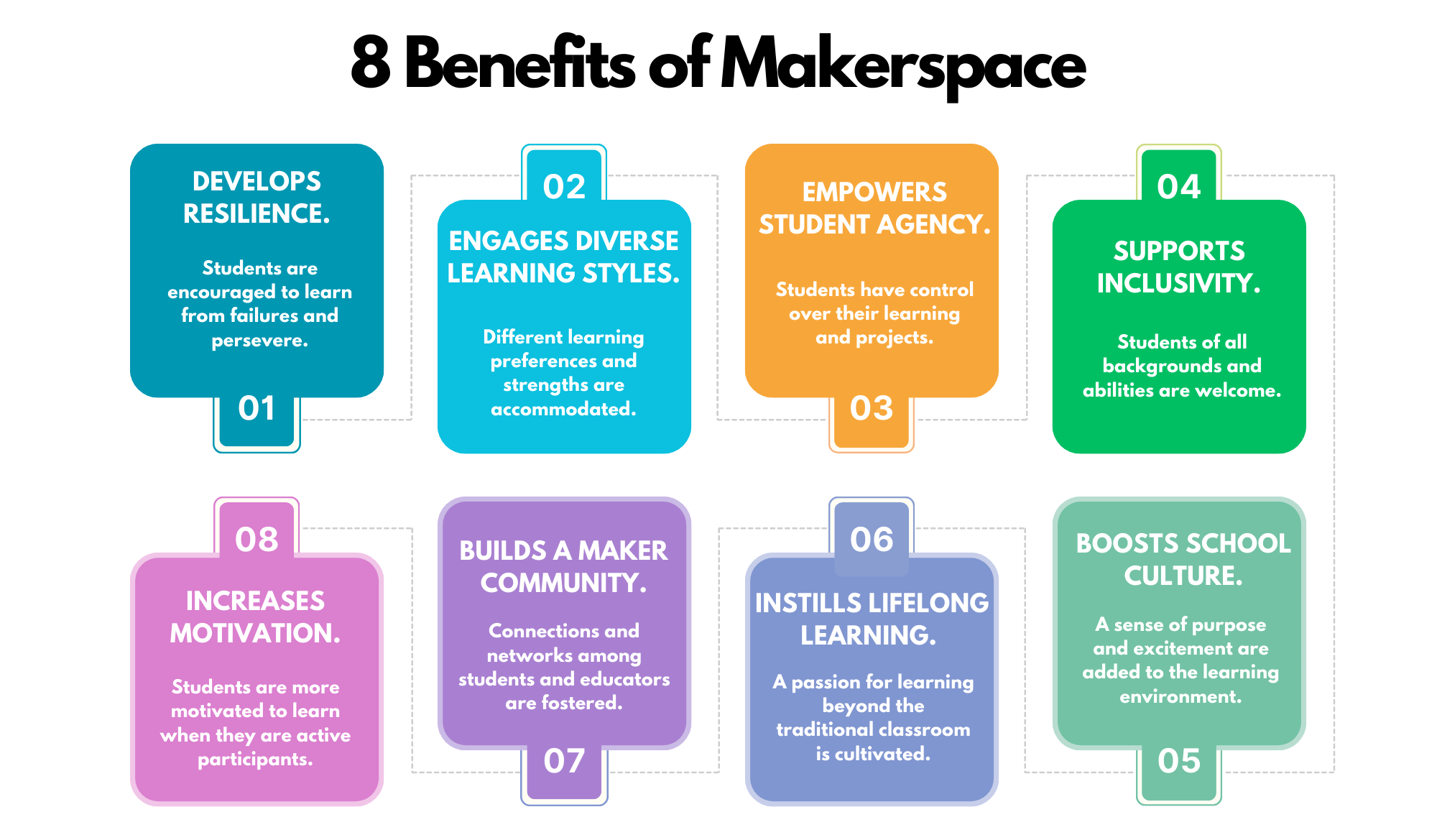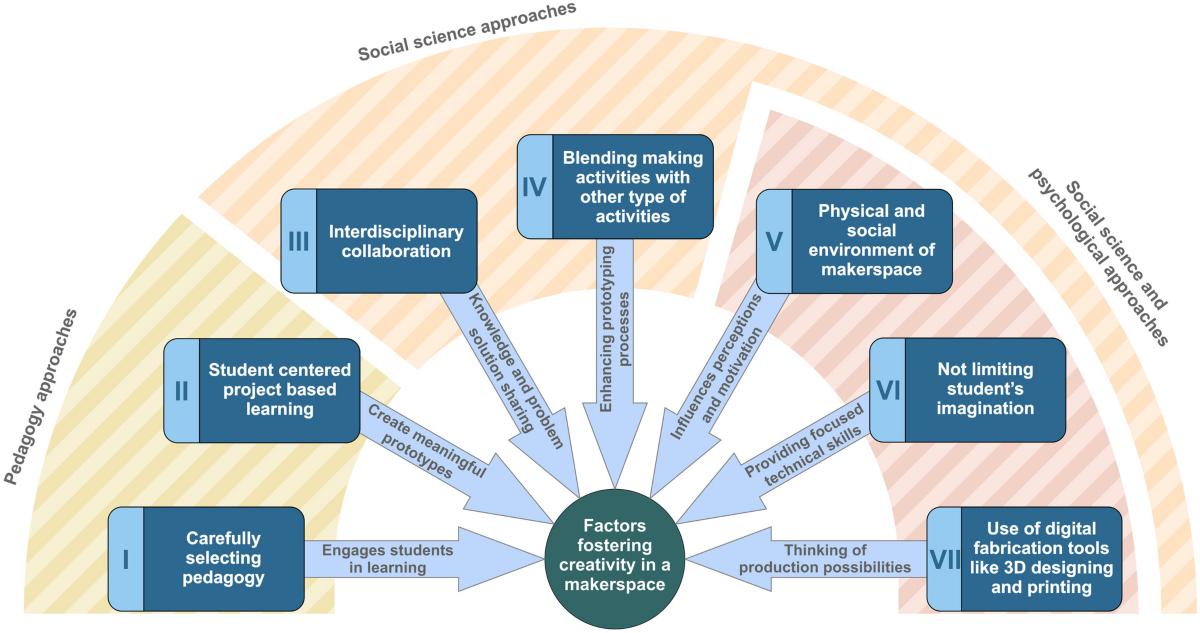MAKERSPACES
INTRODUCTION:
In an era defined by technological innovation and DIY culture, makerspaces have emerged as vibrant hubs of creativity, collaboration, and innovation. These dynamic environments, often found in libraries, schools, community centers, and innovation hubs, provide individuals with the tools, resources, and support they need to bring their ideas to life. Makerspaces represent a departure from traditional learning environments, emphasizing hands-on experimentation, project-based learning, and interdisciplinary collaboration.
- At their core, makerspaces embody the philosophy of DIY (do-it-yourself) and maker culture, encouraging individuals to explore their interests, experiment with materials, and learn by doing. Whether it's woodworking, electronics prototyping, digital fabrication, or textile arts, makerspaces cater to a diverse range of interests and skill levels, fostering a culture of creativity, curiosity, and lifelong learning.
- Makerspaces are equipped with a variety of tools, equipment, and resources to support a wide range of projects and activities. From traditional hand tools and power tools to cutting-edge technologies like 3D printers, laser cutters, and microcontrollers, makerspaces offer a treasure trove of resources for makers to unleash their creativity and turn their ideas into reality.
- But makerspaces are more than just workshops—they are vibrant communities where individuals come together to collaborate, share knowledge, and inspire one another. Community events, workshops, and maker fairs hosted by makerspaces provide opportunities for participants to connect with like-minded individuals, showcase their work, and collaborate on projects that address real-world challenges.
- Education is at the heart of the makerspace movement, with makerspaces serving as informal learning environments that promote hands-on experimentation, critical thinking, and problem-solving skills. By providing learners with opportunities to engage in project-based learning and interdisciplinary exploration, makerspaces complement traditional classroom instruction and prepare individuals for success in an increasingly complex and interconnected world.
In addition to fostering creativity and innovation, makerspaces also play a role in entrepreneurship and economic development. By providing aspiring inventors, entrepreneurs, and small businesses with access to prototyping facilities, mentorship, and networking opportunities, makerspaces support the development and commercialization of new products, technologies, and solutions. Makerspaces contribute to local economies by nurturing a culture of innovation, supporting small-scale manufacturing, and fostering economic growth and revitalization.
Advantages of Makerspaces:
- Hands-on Learning: Makerspaces provide hands-on learning experiences that engage participants in active exploration and experimentation, fostering deeper understanding and retention of concepts.
- Creativity and Innovation: Makerspaces stimulate creativity and innovation by providing individuals with the tools, resources, and freedom to explore their interests, experiment with new ideas, and turn imagination into reality.
- Interdisciplinary Collaboration: Makerspaces bring together individuals from diverse backgrounds and disciplines, facilitating interdisciplinary collaboration and knowledge sharing. Participants can leverage each other's expertise and perspectives to tackle complex problems and create innovative solutions.
- Accessible Technology: Makerspaces democratize access to technology by providing individuals with access to cutting-edge tools and equipment, such as 3D printers, laser cutters, and microcontrollers, that may be prohibitively expensive or inaccessible otherwise.
- Community Building: Makerspaces foster a sense of community and belonging among participants, creating opportunities for networking, mentorship, and social interaction. Community events and activities hosted by makerspaces provide platforms for individuals to connect, collaborate, and inspire one another.
- Skill Development: Makerspaces offer opportunities for skill development across a wide range of areas, including technical skills (e.g., woodworking, electronics, programming), creative skills (e.g., design, arts, crafts), and soft skills (e.g., communication, collaboration, problem-solving).
- Entrepreneurship Support: Makerspaces support entrepreneurship by providing aspiring inventors, entrepreneurs, and small businesses with access to prototyping facilities, mentorship, and networking opportunities. Participants can develop and test prototypes, refine business ideas, and receive feedback from peers and mentors.
Disadvantages of Makerspaces:
- Cost and Resources: Establishing and maintaining a makerspace requires significant financial investment in equipment, materials, and space. Limited funding and resources may restrict the accessibility and sustainability of makerspaces, particularly in underserved communities.
- Technical Barriers: Makerspaces often require a certain level of technical knowledge and skills to operate tools and equipment safely and effectively. Lack of technical expertise or training may hinder participation and limit the potential of makerspace activities.
- Safety Concerns: Makerspaces pose inherent safety risks due to the use of tools, equipment, and materials. Inadequate safety protocols, supervision, and training may lead to accidents or injuries, necessitating careful attention to safety guidelines and risk management practices.
- Digital Divide: Makerspaces may exacerbate existing disparities in access to technology and digital literacy skills, particularly for marginalized or underserved populations. Socioeconomic factors, geographic location, and educational background may influence participation and engagement in makerspace activities.
- Space Limitations: Makerspaces require adequate physical space to accommodate tools, equipment, and workspace for projects. Limited space or overcrowding may restrict the scope of activities and hinder collaboration among participants.
- Maintenance and Upkeep: Makerspace equipment requires regular maintenance, calibration, and upkeep to ensure optimal performance and safety. Lack of funding or technical expertise for maintenance may lead to equipment downtime or deterioration over time.
- Inclusivity and Diversity: Makerspaces must actively promote inclusivity and diversity to ensure equitable access and participation for individuals from all backgrounds and identities. Efforts to address barriers to participation, such as language barriers, cultural differences, or gender stereotypes, are essential for creating an inclusive makerspace environment.
Challenges Faced in Makerspaces:
- Financial Sustainability: Makerspaces often struggle with financial sustainability due to the high costs associated with equipment, materials, rent, utilities, and staffing. Securing funding and revenue streams to cover operational expenses and invest in new equipment and resources can be challenging, particularly for nonprofit or community-based makerspaces with limited financial resources.
- Access to Equipment and Resources: Limited access to specialized equipment, tools, and materials may hinder the ability of makerspaces to support a diverse range of projects and activities. High costs, maintenance requirements, and space limitations may restrict the availability of certain equipment, limiting the scope and impact of makerspace initiatives.
- Technical Expertise and Training: Makerspaces require knowledgeable staff or volunteers to provide training, guidance, and technical support to participants. Recruiting and retaining skilled personnel with expertise in diverse areas, such as electronics, woodworking, and digital fabrication, can be challenging, particularly for volunteer-run or community-based makerspaces.
- Safety and Liability Concerns: Makerspaces pose inherent safety risks due to the use of tools, equipment, and materials. Ensuring proper safety protocols, supervision, and training for participants is essential to prevent accidents or injuries. Makerspaces must also address liability concerns related to accidents or damage to property, requiring adequate insurance coverage and risk management practices.
- Inclusivity and Diversity: Makerspaces must actively promote inclusivity and diversity to ensure equitable access and participation for individuals from all backgrounds and identities. Efforts to address barriers to participation, such as language barriers, cultural differences, or gender stereotypes, are essential for creating an inclusive and welcoming makerspace environment.
- Community Engagement and Outreach: Makerspaces rely on community support and engagement to thrive. Building and maintaining a vibrant community of makers, volunteers, and supporters requires proactive outreach, marketing, and programming efforts. Makerspaces must engage with diverse stakeholders, including schools, libraries, businesses, and community organizations, to raise awareness, attract participants, and secure partnerships.
- Space Limitations and Infrastructure: Makerspaces require adequate physical space to accommodate tools, equipment, and workspace for projects. Limited space or overcrowding may restrict the scope of activities and hinder collaboration among participants. Makerspaces must also invest in infrastructure improvements, such as ventilation systems, power outlets, and storage solutions, to enhance safety, comfort, and usability.
- Equitable Access and Affordability: Ensuring equitable access to makerspaces for individuals of all socioeconomic backgrounds is essential to promote diversity and inclusion. Makerspaces must address barriers to participation, such as membership fees, equipment rental costs, and transportation limitations, to make their services more accessible and affordable to underserved communities.
- Sustainability and Environmental Impact: Makerspaces must consider their environmental impact and adopt sustainable practices to minimize waste, conserve resources, and reduce carbon footprint. Recycling, upcycling, and responsible disposal of hazardous materials are important considerations for makerspaces to promote environmental stewardship and social responsibility.
- Adapting to Technological Advances: Makerspaces must stay abreast of technological advancements and trends to remain relevant and competitive. Investing in new equipment, software, and training to support emerging technologies, such as 3D printing, robotics, and artificial intelligence, can be costly and challenging, requiring strategic planning and resource allocation.
Future Trends in Makerspaces:
- Virtual Makerspaces: With advancements in virtual reality (VR) and augmented reality (AR) technologies, we can expect to see the rise of virtual makerspaces. These digital platforms will enable individuals to collaborate on projects, access tools and resources, and participate in workshops and events from anywhere in the world, transcending geographical barriers and expanding the reach of makerspace communities.
- AI-Driven Tools and Automation: Artificial intelligence (AI) will play an increasingly significant role in makerspaces, powering smart tools and equipment that can automate repetitive tasks, optimize workflows, and enhance productivity. AI-driven design assistants, predictive maintenance systems, and intelligent fabrication tools will streamline the making process and empower makers to focus on creativity and innovation.
- Integration of Biotechnology and Biohacking: Makerspaces will embrace biotechnology and biohacking as emerging areas of interest, allowing individuals to experiment with living organisms, genetic engineering, and synthetic biology. DIY biolabs and biohacker spaces will provide opportunities for hands-on exploration of bio-related projects, such as bio fabrication, bio art, and DIY diagnostics.
- Sustainability and Circular Design: Makerspaces will increasingly prioritize sustainability and circular design principles, promoting eco-friendly practices, waste reduction, and upcycling of materials. Projects focused on renewable energy, zero-waste manufacturing, and sustainable agriculture will proliferate, reflecting a growing emphasis on environmental stewardship and social responsibility.
- Remote Collaboration Tools: As remote work and virtual collaboration become more prevalent, makerspaces will adopt advanced collaboration tools and platforms that enable remote participation and co-creation. Virtual reality (VR) conferencing, cloud-based project management, and real-time collaboration software will facilitate global collaboration among makers, researchers, and educators.
- Open-Source Hardware and Software: Makerspaces will continue to embrace open-source hardware and software as foundational principles, fostering a culture of sharing, collaboration, and innovation. Open-source projects, DIY kits, and maker communities will democratize access to technology, empower individuals to customize and modify tools, and drive collective innovation in the maker movement.
- Robotics and Automation: Robotics and automation will become increasingly prevalent in makerspaces, enabling individuals to explore robotics projects, automation solutions, and intelligent systems. DIY robotics kits, programmable microcontrollers, and collaborative robots ( will empower makers to design and build their own robots for education, research, and entertainment purposes.
- Inclusive and Accessible Design: Makerspaces will prioritize inclusive and accessible design practices to ensure that their facilities, tools, and resources are accessible to individuals of all abilities and backgrounds. Efforts to address barriers to participation, such as physical accessibility, sensory-friendly environments, and culturally inclusive programming, will promote diversity and equity within makerspace communities.
- Artificial Intelligence and Machine Learning Projects: Makerspaces will explore applications of artificial intelligence (AI) and machine learning (ML) in various domains, including computer vision, natural language processing, and predictive analytics. Projects involving AI-driven artworks, interactive installations, and intelligent systems will push the boundaries of creativity and technology in the maker movement.
- Hybrid Makerspaces and Co-working Spaces: Makerspaces will evolve into hybrid environments that combine elements of traditional makerspaces with co-working spaces, incubators, and innovation hubs. These hybrid spaces will offer a range of amenities, services, and resources to support makers, entrepreneurs, and small businesses, fostering a culture of innovation, collaboration, and entrepreneurship.
Conclusion:
- Makerspaces represent more than just physical workshops—they embody a culture of creativity, collaboration, and innovation that transcends boundaries and empowers individuals to explore their passions, develop new skills, and tackle real-world challenges. Despite facing numerous challenges, from financial sustainability to inclusivity and diversity, makerspaces continue to thrive as vibrant hubs of learning, experimentation, and community engagement.
- As we look to the future, makerspaces will play an increasingly vital role in shaping the way we learn, work, and create. By embracing emerging technologies, fostering inclusivity and diversity, and promoting sustainability and social responsibility, makerspaces have the potential to catalyze positive change and drive innovation across diverse domains, from education and entrepreneurship to art and social impact.
- Ultimately, the true power of makerspaces lies in their ability to inspire, empower, and connect individuals from all walks of life, fostering a culture of lifelong learning, collaboration, and possibility. As we navigate the challenges and opportunities of the 21st century, makerspaces serve as beacons of creativity and resilience, driving us forward on a journey of exploration, discovery, and transformation.








Comments
Post a Comment